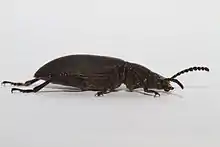Zophobas morio
Zophobas morio is a species of darkling beetle, whose larvae are known by the common name Superworms, King Worms, Morio Worms or simply Zophobas. Superworms are common in the reptile pet industry as food, not to be confused with giant mealworms, which are Tenebrio molitor larvae sprayed with juvenile hormone.
| Zophobas morio | |
|---|---|
.jpg.webp) | |
| Scientific classification | |
| Kingdom: | Animalia |
| Phylum: | Arthropoda |
| Class: | Insecta |
| Order: | Coleoptera |
| Family: | Tenebrionidae |
| Genus: | Zophobas |
| Species: | Z. morio |
| Binomial name | |
| Zophobas morio (Fabricius, 1776) | |
The insect's larvae resemble very large mealworms, about 50 to 60 mm (1.7–2.25 in) long when full size, but unlike mealworms, the ends of their bodies are very dark, almost resembling a black color. They have 6 small legs and two rudimentary hind prolegs. Once they reach adult size, the larvae pupate, and later emerge as large, light coloured beetles, which in time darken to black beetles. The larvae will not pupate if kept in a container with many other larvae and plentiful food, where they receive constant bodily contact. Keeping superworms this way is commonly used to hinder pupation. To mature the superworms into darkling beetles, they must be kept alone for about 7–10 days. They will then, upon maturation, emerge from their pupal stage as darkling beetles.
Superworms are accepted by lizards, turtles, frogs, salamanders, birds, koi and other insectivorous animals, as well as pet ants. Their nutritional values are similar to those of mealworms, so it is possible that supplementation with calcium is necessary if they are used as a staple food item. In some cases they are preferred over mealworms due to their softer exoskeleton, making them more digestible to some reptiles. The larvae are odor-free (but the beetles possess a pungent chemical defense that may be released when provoked), and can be easily contained, making them ideal for raising at home to feed a collection of captive insectivores. In Brazil, the main insects in captivity are intended to feed animals only. The nutritional profile of the Zophobas morio is, "46.80% proteins, 43.64% lipids, 8.17% ashes and 1.39% carbohydrates."[1]
Relationship with humans
As pet feed
As with the popular mealworm, ' larvae (commonly known as superworms) are widely used in pet care, more specifically as feed.
Superworms are relatively high in protein and fat, which make them attractive pet feed for captive reptiles, amphibians, fish, and birds. Their ability to stay alive without eating for 1-2 weeks makes the keeping process highly feasible for bulk commercial availability around the world. However, pet owners are advised to keep them in warm temperatures as, unlike the mealworm, superworms do not enter the process of hibernation. They are also known to bite when threatened by handling.
As waste disposal agents
In 2016, it was discovered by a group of high school students in Ateneo de Manila University that Zophobas morio larvae may be used in waste disposal as the larvae were found to consume expanded polystyrene foam. The research study compared the larger Zophobas morio larvae to the Tenebrio molitor larvae, which were previously used in a Stanford study tackling polystyrene degradation.[2][3] The former study found that in equal bulk-weight categories, the Zophobas morio larvae may consume greater amounts of polystyrene for longer periods of time.
See also
Gallery
 Young beetle
Young beetle Adult beetle
Adult beetle Pinned adult specimen
Pinned adult specimen
References
- Soares Araújo, Rafael Ribeiro; dos Santos Benfica, Tatiana Aparecida Ribeiro; Ferraz, Vany Perpetua; Moreira Santos, Eleonice (March 2019). "Nutritional composition of insects Gryllus assimilis and Zophobas morio: Potential foods harvested in Brazil". Journal of Food Composition and Analysis. 76: 22–26. doi:10.1016/j.jfca.2018.11.005.
- Jordan, Rob. "Plastic-eating worms may offer solution to mounting waste, Stanford researchers discover". Stanford News Service. Retrieved May 21, 2020.
- Aumentado, Dominic. "A Comparative Study of the Efficacy of Tenebrio molitor larvae and Zophobas morio larvae as Degradation Agents of Expanded Polystyrene Foam". Academia. Retrieved May 5, 2020.
Further reading
- Freye, Henry B.; Esch, Robert E.; Litwin, Catherine M.; Sorkin, Louis (1 July 1996). "Anaphylaxis to the Ingestion and Inhalation of Tenebrio molitor (Mealworm) and Zophobas morio (Superworm)". Allergy and Asthma Proceedings. 17 (4): 215–9. doi:10.2500/108854196778996903. PMID 8871741.
- Leung, Dong; Yang, Depo; Li, Zhuoxue; Zhao, Zhimin; Chen, Jianping; Zhu, Longping (5 January 2012). "Biodiesel from Zophobas morio Larva Oil: Process Optimization and FAME Characterization". Industrial & Engineering Chemistry Research. 51 (2): 1036–1040. doi:10.1021/ie201403r.
- Prado, R. A.; Santos, C. R.; Kato, D. I.; Murakami, M. T.; Viviani, V. R. (2016). "The dark and bright sides of an enzyme: a three dimensional structure of the N-terminal domain of Zophobas morio luciferase-like enzyme, inferences on the biological function and origin of oxygenase/luciferase activity". Photochemical & Photobiological Sciences. 15 (5): 654–665. doi:10.1039/C6PP00017G. PMID 27101527.
- Latney, La'Toya V.; Toddes, Barbara D.; Wyre, Nicole R.; Brown, Dorothy C.; Michel, Kathryn E.; Briscoe, Johanna A. (February 2017). "Effects of various diets on the calcium and phosphorus composition of mealworms (Tenebrio molitor larvae) and superworms (Zophobas morio larvae)". American Journal of Veterinary Research. 78 (2): 178–185. doi:10.2460/ajvr.78.2.178. PMID 28140633.
| Wikispecies has information related to Zophobas morio. |
| Wikimedia Commons has media related to Zophobas morio. |